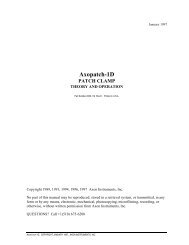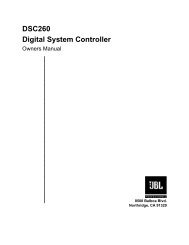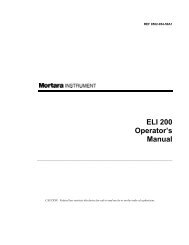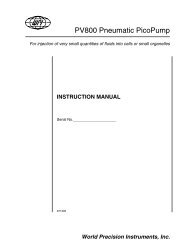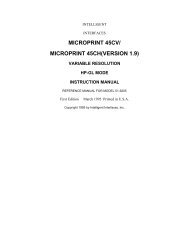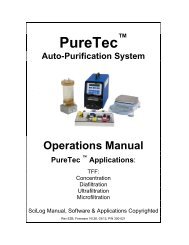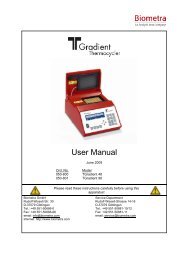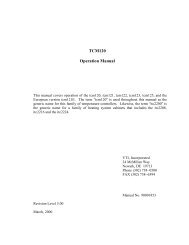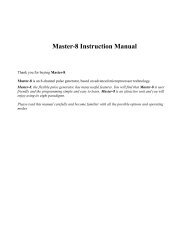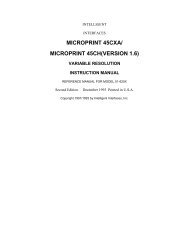Chromatotron
Chromatotron
Chromatotron
Create successful ePaper yourself
Turn your PDF publications into a flip-book with our unique Google optimized e-Paper software.
All rotors, new or used, must be thoroughly cleaned within 1/2 hr of<br />
coating. Do not rely on glass washing services. Follow the cleaning<br />
instructions carefully! Detachment of sorbent layers will be a serious<br />
nuisance if rotors are not scrupulously clean.<br />
Cleaning and Setting Up the Rotor For Coating<br />
Mount the rotor ground side up in the coating arbor and tighten gently by<br />
turning the edge of the rotor while holding the plastic handle. The rate of<br />
accidental rotor breakage will be high if the arbor and handle are not used<br />
during cleaning.<br />
Thoroughly scrub the upper surface with<br />
water and Ajax or similar abrasive<br />
household cleanser powder, using a wad<br />
of paper towels, nylon scouring pad or a<br />
small stiff brush. Wash well and check for<br />
effective cleaning by allowing the water to<br />
drain off for about 15 sec. If separate drops<br />
of water form on the rotor then the cleaning is<br />
not complete and should be repeated.<br />
Dry with paper towels only. Use at least<br />
two, wiping first the cleaned upper surface then the other parts of the rotor and<br />
arbor. A final wipe of the dry rotor with a dry towel will remove lint. Do not dry<br />
with acetone or by heating in an oven.<br />
Attach 3/4" (2 cm) masking tape<br />
(preferred) or other adhesive tape<br />
(cellulose tape may be used but will<br />
leave adhesive on the glass) to the<br />
edge of the rotor as shown. Press<br />
the tape on firmly to the edge and<br />
underside of the rotor. Attach extra<br />
pieces of tape as required. For easy<br />
removal of the tape later, form a tab by bending over the tape end.<br />
Place on a rigid level surface covered by a piece of thin felt, cloth or a single<br />
layer of a paper towel, taped down. The surface used must be free from<br />
vibration caused by nearby equipment. Use grommets or a short length of<br />
rubber tubing on the rod of the arbor as a finger grip.<br />
Mixing and Pouring the Recipe<br />
Weigh out the sorbent and binder into a preserve or pickle jar or other widemouth<br />
container with a screw-on cap giving a liquid-tight seal. Erlenmeyer<br />
(conical) flasks are inconvenient. For easy mixing the jar should be not more<br />
than 70% full of the dry sorbent and binder. Usual jar size: 1 mm layers, 250-<br />
400 ml, 2 mm, 300-400 ml, 4 mm, 400-600 ml.<br />
25



